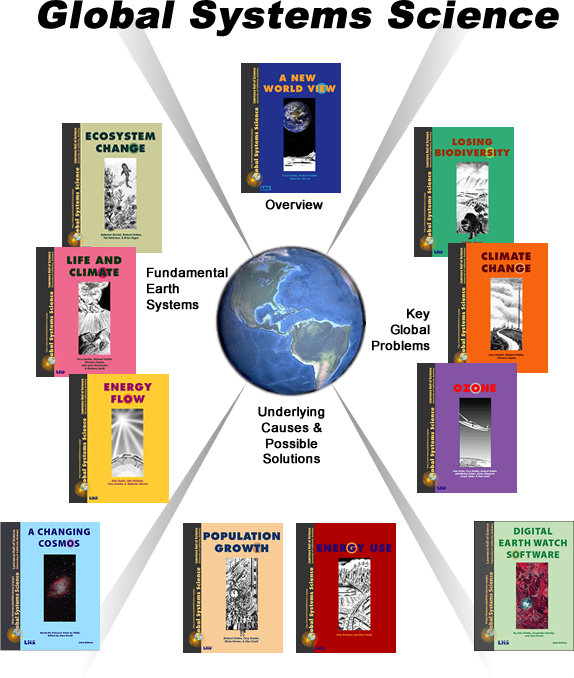Global Systems Science Teacher Guides Available
For a link to the GSS Teacher Guides, send a message to gssmail@berkeley.edu with subject line: GSS Teacher Guides. In your message, please state your first & last name, school, city, and state, contact information, and how you are using or plan to use GSS materials, e.g. a course you are teaching or school district you are serving if you’re a science coordinator. Expect a reply within a week of sending your message.
The Teacher Guides have many additional Investigations with pages you can copy and provide your students. The Teacher Guides explain and answer the questions below:

- How can I customize GSS for my students?
- How can I sequence the Guides in a one year course?
- What will my students learn?
- What teaching methods should I use?
- How can I assess student learning?
- How is GSS related to science education reform?
- What support do I need to implement GSS?
- Who created GSS and how was it created?
Professional Development
Professional development for Global Systems Science teachers began with summer institutes in 1993, 1994, and 1995. You may read an excellent overview of the principles and philosophy of those institutes, written by the first GSS Director, Cary Sneider, as an illustration of an exemplary professional development program for a landmark 1998 book on professional development by Susan Loucks-Horsley, Peter W. Hewson, Nancy Love, and Katherine E. Stiles: Designing Professional Development for Teachers of Science and Mathematics. Read specifically Resource D: Global Systems Science: A Professional Development Program for High School Teachers (pages 289–294 of the 1998 edition)
Lifelines for High School Climate Change Education
This was a NASA grant project, 2010–2013. Project Goals:
- establish a network of practicing high school teachers actively using climate change curricula—create professional learning communities (PLCs) of teachers
- hold remote (travel-less) meetings and workshops as much as possible
- explore techniques to achieve the most effective teleconferencing meetings and workshops.
- practice what we preach: promote not only teaching about minimizing environmental impacts of human activity, but minimize environmental impacts of professional development.
- maintain ongoing communication and sharing of best practices among colleagues
- strengthen knowledge and promote effective teaching strategies during and beyond the actual grant period.
- as a project of the NASA Innovations in Climate Education (NICE), Lifelines incorporates analysis of NASA Earth observation data by students in classrooms.
The project was designed with a cascading effect, recruiting and training 20 climate change education teacher leaders who then form the PLCs comprised of 15 high school science teachers, for a total of 320 teachers involved in the project.
- Course Outlines and Resources from/for PLC Members
- Leaders’ Site including archive of presentations made
- Final report to NASA: NNX10AB60A_FinalReport.pdf
The partner organizations included:
- Global Systems Science (GSS), a high school science curriculum widely used in integrated science, Earth science, and environmental science courses, is the lead proposer of the project. GSS provides tried and true resources, including Climate Change and Life and Climate.
- LHS Great Explorations in Math and Science (GEMS) with an existing network of over 80 professional development (PD) sites and centers, across the United States.
- Earth Science Information Partners (ESIP), of which GSS is a member will provide avenues for recruitment of participants, speakers for the remote teacher workshop events, and useful resources such as Earth Exploration Toolkit, GLOBE, and Earth System Science Education Alliance (ESSEA), Measuring Vegetation Health (MVH), and Forest Watch.
- EOS Webster with access to NASA Earth satellite imagery.
- Climatechangeeducation.org
GSS Conference
View the proceedings from the 2003 GSS Conference in Philadelphia.
Miscellaneous
- Strategies for Computer Use with GSS
- Materials lists for the GSS student investigations
- 2025: The American Geophysical Union (AGU) science news magazine Eos introduced ENGAGE, a resource designed for high school and undergraduate science teachers to improve science literacy and the use of science writing as narrative nonfiction resources. It has professionally reported articles, curated by Eos editors, suited for engagement material for Earth and space science lessons.

